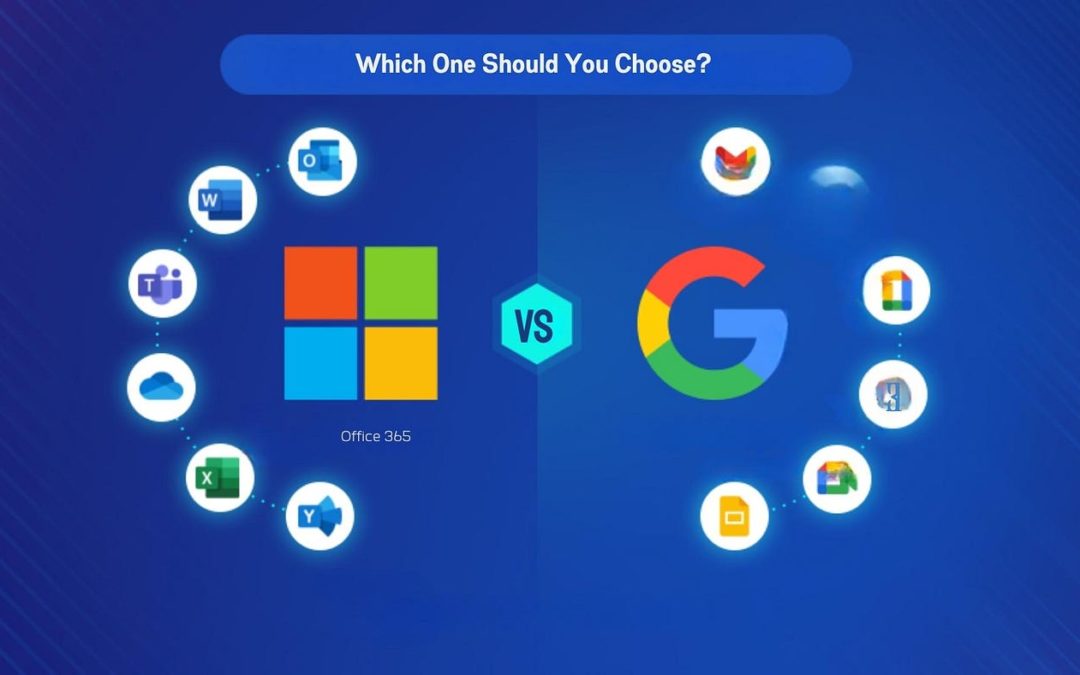Selecting the right productivity suite is crucial for any business. Two major contenders dominate the market: Microsoft 365 vs Google Workspace. Both offer a range of tools designed to improve productivity, communication, and collaboration. In this article, we’ll delve into the key features and benefits of each, compare their pricing structures, and discuss the role of a local IT provider like ATYXIT in helping businesses make the right choice from the start. We will help you understand the significant differences and advantages each platform offers.
Key Features and Benefits
Microsoft 365
Microsoft 365, formerly known as Office 365, is a comprehensive suite of applications that includes Word, Excel, PowerPoint, Outlook, and OneNote, among others. One of its standout features is its robust set of desktop applications, which are known for their advanced functionalities and offline capabilities.
- Advanced Desktop Applications: Microsoft 365 is renowned for its powerful desktop applications. Tools like Word and Excel offer advanced features that are essential for complex document creation and data analysis.
- Seamless Integration with Windows: Given that Microsoft 365 is a Microsoft product, it integrates seamlessly with the Windows operating system, providing a more unified user experience.
- Collaboration Tools: Microsoft Teams is a powerful collaboration tool included in the suite, offering chat, video conferencing, and file sharing capabilities, which are essential for remote work environments.
- Security: Microsoft 365 offers robust security features, including advanced threat protection, encryption, and compliance tools, making it a preferred choice for businesses that prioritize data security.
Google Workspace
Google Workspace, formerly known as G Suite, is a cloud-based productivity suite that includes Gmail, Google Drive, Google Docs, Google Sheets, and Google Meet. Its simplicity and cloud-centric approach make it a popular choice, especially for businesses that prioritize collaboration, accessibility and ease of configuration.
- Cloud-Based Applications: Google Workspace is entirely cloud-based, which means all your documents and files are accessible from any device with an internet connection. This feature is particularly beneficial for remote teams.
- Real-Time Collaboration: Google’s applications, such as Docs and Sheets, are designed for real-time collaboration, allowing multiple users to work on the same document simultaneously.
- Ease of Use: The interface of Google Workspace applications is intuitive and easy to use, making it accessible even for those who are not tech-savvy.
- Integration with Google Ecosystem: Google Workspace integrates seamlessly with other Google services like Google Calendar and Google Drive, creating a cohesive work environment.
Pricing Differences
When comparing Microsoft 365 vs Google Workspace, pricing is a crucial factor to consider. Both platforms offer various plans to cater to different business needs.
Microsoft 365 Pricing:
- Microsoft 365 Business Basic: $6 per user/month
- Microsoft 365 Business Standard: $12.50 per user/month
- Microsoft 365 Business Premium: $22 per user/month
Google Workspace Pricing:
- Business Starter: $6 per user/month
- Business Standard: $12 per user/month
- Business Plus: $18 per user/month
While both suites have comparable entry-level pricing, Microsoft 365’s higher-tier plans are generally more expensive but come with additional features like advanced security and desktop applications. Google Workspace, on the other hand, offers slightly more affordable higher-tier plans but is primarily focused on cloud-based solutions and does not include as many tools and security features with their higher-tiered plans.
The Importance of Choosing the Right Solution
Selecting the right productivity suite from the start is crucial for several reasons:
- Scalability: The right solution will scale with your business, accommodating growth without requiring a significant overhaul of your systems.
- Productivity: A suite that aligns with your team’s workflow will enhance productivity, making everyday tasks more efficient.
- Cost-Effectiveness: Choosing the right plan can save your business money in the long run by avoiding unnecessary features and paying for what you actually need.
- Security: Ensuring that the suite you choose has the necessary security features to protect your data is essential in today’s digital landscape.
The Role of a Local IT Provider
A local IT provider such as ATYXIT plays a critical role in helping businesses select and configure their productivity suites. Here’s how we can assist:
- Needs Assessment: We assess your business’s specific needs and recommend the best solution, whether it’s Microsoft 365 or Google Workspace.
- Implementation: We handle the setup and migration process, ensuring that the transition to the new platform is smooth while minimizing downtime.
- Training: We offer training sessions to help your team get up to speed with the new tools, ensuring a quick adaptation.
- Ongoing Support: Post-implementation, we offer continuous support and maintenance, helping resolve any issues that arise while keeping your systems up to date.
Our security-first approach to Managed IT Services ensures that your entire infrastructure, including Google Workspace or Office365 is configured with security in mind.
Conclusion
In the debate of Microsoft 365 vs Google Workspace, there is no one-size-fits-all answer. The right choice depends on your business’s specific needs, budget, and workflow preferences. Microsoft 365 is ideal for businesses that require advanced desktop applications and robust security, while Google Workspace is perfect for those prioritizing cloud-based solutions and real-time collaboration. Engaging a local IT provider can simplify the decision-making process, ensuring you select the right solution from the start and get the most out of your investment.
Should you require any assistance with your email or anything else technology related, you can contact us through our contact form, our phone number or our email all of which can be found at our Contact us page.

